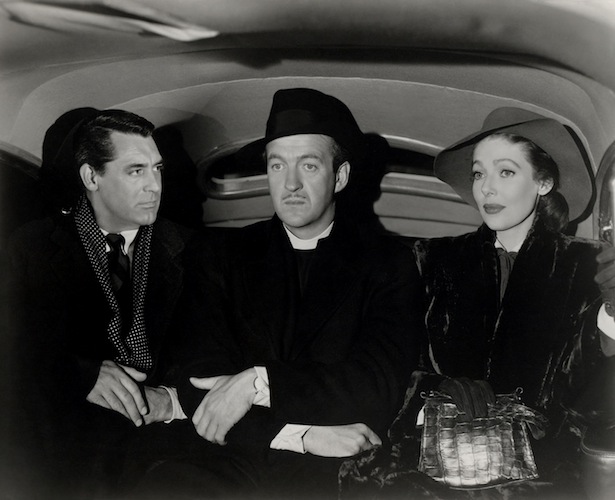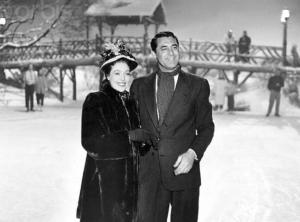Film Commentary: “The Bishop’s Wife” — Realistic Christmas Sentiment
Though disguised in holiday trappings, 1947’s “The Bishop’s Wife” is about human frailty, thwarted ambition, and the humble rewards that accompany doing the right thing.
By Jay Atkinson
In December, our tablets, televisions, and phones are visited by the ghosts of Christmas past, an array of black and white movies that transport us back to a country we’ve long since departed from.
For many of us, these holiday films were already decades old when we first watched them, on rabbit-eared TVs that got only four or five channels. It was a simpler time, the era of our early Christmases, and watching these movies with our own kids has become a cherished family tradition. Usually lost in the procession of wonderful lives, miracles on Manhattan streets, and visions of Ebenezer Scrooge flying over London, is an overlooked 1947 classic that’s worth downloading, or borrowing on DVD from your local library.
Starring Cary Grant, David Niven, and Loretta Young, The Bishop’s Wife is the tale of a young Episcopal bishop struggling to raise four million dollars to build a grand cathedral in an unnamed city. The beleaguered clergyman, played by Niven, ignores his lovely young wife and daughter, as well as the approaching Christmas season, fretting over blueprints and the whims of his condescending benefactor, a rich, cranky widow. Enter the mysterious stranger, Dudley, portrayed by Grant, who performs numerous good deeds, informs Niven’s character that he’s been sent to assist him, and claims to be an angel.
A Samuel Goldwyn film partly shot in Minneapolis, The Bishop’s Wife contains several wonderful sequences. In one scene, Grant convinces Niven’s wife, the radiant Loretta Young, and their crusty old cab driver to go ice-skating at night in the local park. To the strains of a Salvation Army band, Young finds herself gliding over the burnished surface of the pond in the arms of Cary Grant.
“Oh, Dudley,” she says. “This is heaven.”
Although the more intricate maneuvers were undertaken by stunt doubles, Grant, a traveling acrobat in his youth, leads Young in a charming waltz that whisks her—and us—back to the unencumbered joys of youth. Another set piece depicts Grant in the basement of an old church, assembling a choir from what appears to be a motley group of street urchins. (The ensemble was actually an accomplished group called the Mitchell Boychoir.) As the boys wander in, sitting down in twos and threes, their voices combine in a magnificent, soaring rendition of “Noel,” accompanied by a brilliantly-framed series of shots by Academy Award-winning cinematographer Gregg Toland.
Though disguised in holiday trappings, The Bishop’s Wife is about human frailty, thwarted ambition, and the humble rewards that accompany doing the right thing. While gently admonishing the bishop that his priorities are all wrong, Grant’s wry, handsome angel, descended to earth in human form, must also wrestle with his own conflicted emotions. As the movie arcs toward its climax, Grant seems confused by his growing fondness for Niven’s beautiful, innocent wife. When he informs her that his time with their family is growing short, Young asks if she will ever see him again.
“They never send us to the same place twice,” says Grant, with a wistful smile. “We might form attachments.”
Niven arrives home just as his wife goes running upstairs, obviously upset. Approaching his visitor, the bishop doffs his hat, thrusts aside his topcoat, and says, “I’ve never before had to fight an angel, but I suggest you take off your coat and put up your dukes!”
Grant shrugs off the remark, but Niven’s character persists in his anger, saying, “I was praying for a cathedral!”
“No, Henry,” Grant says. “You were praying for guidance.”
In The Bishop’s Wife, none of the characters quite get what he or she wants. But there’s a sense of quiet realism here that’s often lacking in holiday films—a feeling that these people will soldier on with their lives, even after we’re done watching them. And when the story concludes, with the bishop delivering a sermon in the modest church where he launched his career, we’re reminded of the quiet moments in our own lives, and of what Christmas is all about.
Jay Atkinson is the author of seven books, including Legends of Winter Hill. He teaches writing at Boston University. Follow him on Twitter@atkinson_jay




This is a great commentary/summary on a wonderful movie. Hoping your words will inspire others to view it and be encouraged by this story.
Simply put, although this one is all about Grant’s charm, no more, no less, and there’s a story here about an angel helping out a Catholic bishop (David Niven in a thankless role as the representative of all believers who only want things their way), but it hardly matters at all as the underlying message, faith in the good will of all (inspired by a higher power?) is a rationale for hope in dark times. Which makes this a Christmas charmer for the ages. The ice skating number in the middle is still one of my favs from my youth.
I believe he was Episcopalian…Catholic priests don’t marry…LOL
He was Episcopalian!
Actually, Niven is an Episcopal bishop aka Anglican).
Catholic priests, (including bishops at the next level of hierarchy), cannot marry.
One of my all-time favorite Christmas movies. Grant and Young did not like one another in person but there seems to such chemistry between them in the film! Grant’s charm captivates me every time I watch this film, a holiday tradition and Young’s soft spoken voice soothes the soul.A holiday must!
Right you are! A perfect description! This warm, easily paced film is a joy to watch and its elegant sets reminds of an era that most of us are too young to have experienced. Cary Grant, Loretta Young and Elsa Lancaster contribute for a most convincing ensemble.
One of our three top movies to watch over the holidays. The Bishop’s Wife, Prancer (with Sam Elliot) and One Magic Christmas. And most of our friends haven’t heard of any of the three.
Thank you for this! Though I didn’t grow up with any awareness of this wonderful film (or Christmas in Connecticut, another terrific Christmas movie), as an adult it’s pretty much been my December backdrop since the 1980s.
The performance by the Mitchell Boychoir is one of my favorites for the holiday season, but the kids weren’t depicted as street urchins – they were simply the neighborhood kids who were distracted by Christmas and the basketball season, and not all that into being in the church choir. Nor were they assembled by Dudley – they were church members. Dudley just miraculously lured them all in for the practice that Mr. Miller seemed convinced most of them would miss. And Dudley also made them sound much, much better!
I’m curious about filming locations. You mentioned Minneapolis but I always believed it was filmed on the studio backlot, and that all interiors were stage sets. If you have any info on locations off the lot, I’d love to know more. Thanks again.
I love the movie, but have always wanted a tree like that. What is the name of the the tree so I can finally find one. Thanks so much.
Robbie, I’m afraid they don’t sell them—or grow them—like this anymore. As a child in 1950’s Southern California, this was the type of tree my family bought every year —the variety we got was called a Silver Tip fir. (If you ever find a place that still sells Silver Tips, PLEASE post it on this site!)
Is their house in Minneapolis still sanding ? Was it a real house
i’m 72 years old and have seen the bishop’wife many times over the years. i still believe this to be the very best christmas film ever made!
Have you seen “It’s A Beautiful Life”?
One of my favorite winter/Christmas classics
Sorry, I meant to name the movie “It’s A Wonderful Life”!
I’m 71, John, and I don’t know a better one. I’ve seen it only once, too, which I should do something about. I’ve been trying to convince a middle aged woman who is a wife and a mother, and whom I’ve developed a nice interaction with in a Substack comments section, to watch it, but she saw the Denzel Washington remake when she was young, hated it, and so far, has remained immune to my explanation that the remake is far different from the original.
I always loved Grant’s subtle acting, look at his facial expressions when Young takes his arm to cross the street. A look of surprise, then pleasure as he pulls her arm closer to his.
I’m 51 years old and I have been watching The Bishop’s Wife for 20 years now, I never miss, I bought it on dvd. So every year I watch it, I watch it’s a wonderful life, numerous versions of a Christmas Carol, White Christmas and Miracle on 34 st. All the original cuts except A Christmas Carol of course I have several versions. But my lil boys watches them too
Your comments made me smile! Its nice to see people appreciating such a fine movie. It’s one of my favorites! I have loved classic movies since the 1st time I watched Shirley Temple’s The Little Princess as a small child. My youngest daughter also loves them! My husband won’t even glance at a black and white movie. I personally enjoy movies made in the 1940’s the most, even though I wasn’t born till the late 60’s The world was a different place back then. Now, I’ll grab my popcorn and string and make garland while I watch Miracle on 34th St. Merry Christmas to all of you!
You have excellent taste, which, alas, your husband seems not to have. I know we’re told that younger people can’t stand black and white because they’re so much more visually literate than we old folks ( b. 1952, in my case ), but I think it’s the opposite, that the more visually literate you are, the likelier you are to be able to relish black and white film. It can be so visually subtle, depending on exacting lighting to create precisely the right looks and shadows, yet simple at the same time.
Cary Grant should have received an academy award!
A Masterpiece!!
Absolutely beautiful this movie… I love these old films.. the best!